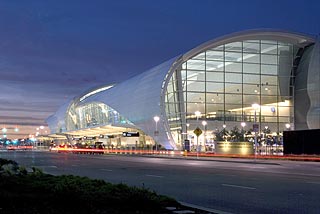Platinum Award
Project: Mineta San Jose (Calif.) International Airport Terminal B and Concourse
Client: Mineta San Jose International Airport

Photo by Kris Knutson A frame system designed by Magnusson Klemencic Associates for a new terminal and concourse at the Mineta San Jose (Calif.) International Airport uses steel trusses to resist gravity, seismic and wind loads.
|
The Platinum Award was presented to Magnusson Klemencic Associates for adapting its “special truss moment frame” structural design system to build a seismically resilient, cost-effective and artistically challenging new terminal for the Mineta San Jose (Calif.) International Airport.
The terminal expansion was driven by urban growth, but its location in the most active and populous earthquake area in the United States created some design obstacles. Traditional structural design methods were not going to work at this site, which is hemmed in on all four sides, plus from above and below. The special truss moment frame, or STMF, met the challenges and was the critical component in the successful completion of the new terminal.
By the late 1990s the San Jose airport had become seriously undersized, outdated and at risk of losing resident airlines.
Its Silicon Valley location was central to the region’s technology industry, including 29 of the nation’s top 100 fastest-growing technology companies. More than 6,000 people work for various employers at the airport, which generates an estimated $4 billion in local business economic activity annually and nearly 50,000 jobs in the San Jose/Silicon Valley region. The expansion and improvements were needed to keep up with demand.
But then the Sept. 11 attacks happened, along with the dot-com decline, challenging but not eliminating the need for the new terminal and other improvements. The project time frame was shortened from 12 years to three, and the budget was reduced by two-thirds.
MKA’s STMF design program provided a way for the airport to accomplish its goals. STMF is a form of moment-resisting frame that uses steel trusses to resist gravity, seismic and wind loads. When the design-build team discovered they could reduce costs and increase functionality if Terminal B were moved several hundred feet and connected to the new concourse, STMF showed how it could be done.
No longer was a separate structural system needed for Terminal B, or even a proposed temporary terminal. Also, basement space beneath the terminal and adjacent concourse could be developed to accommodate the new in-line baggage screening system.
Ultimately, the project was completed ahead of schedule and came in significantly under budget. The addition of Terminal B and the concourse increased the airport’s passenger capacity by nearly 40 percent, from 10.4 million to 14.4 million annually.
While running a sophisticated performance-based analysis to make sure STMF’s design would actually work, engineers discovered an error in the national structural code formulas used by all U.S. engineers, and were able to appeal to national code development committees and have the appropriate corrections made. In addition, MKA’s use of its STMF system on the airport was incorporated as a precedent-setting case study in a national engineering code reference book.